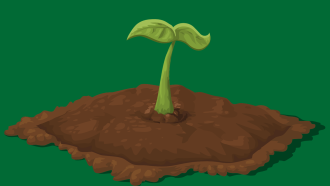![Chickpea pods [Image Credits: Wikimedia Commons] Tapping genes to make chickpeas resistant to droughts](/sites/researchmatters/files/styles/large_800w_scale/public/yamuna-drought_chb1.jpg?itok=h_zde9k5)
Chickpea pods [Image Credits: Wikimedia Commons]
The lip-smacking channa chat or the chole masala has a quintessential ingredient—the humble chickpea or Bengal gram. This pulse, believed to have originated in Turkey, is a rich source of protein and dietary fibre. The crop takes just three to four months from sowing to be ready for harvest and prefers a cool climate with low rainfall. Today, India is the world’s largest chickpeas producer and contributes to 70% of the world’s production. However, drought can play a spoilsport and reduce the yield by up to 45%.
In a recent study, researchers from the Indian Agricultural Research Institute, Delhi, International Crops Research Institute for the Semi-Arid Tropics (ICRISAT) in Telangana, along with those from the National Institute of Plant Biotechnology, Delhi, have identified a gene that could make chickpeas tolerant to drought. The study, published in the journal PLOSOne, was partially funded by the Department of Biotechnology (DBT), Government of India.
“Chickpea is highly susceptible to drought. Many genes control how the plant tolerates drought and identifying them remains a challenge for breeders,” says Dr C Bharadwaj, the corresponding author of the study, who also led it. He is a geneticist at the Indian Agricultural Research Institute.
In other crops, the role of the Abscisic acid-, stress-, and ripening gene (also called the ASR gene) is known to bestow tolerance to drought. However, its molecular function in chickpeas wasn’t yet known. “The present study identifies the function of ASR gene in chickpea,” he says.
When plants are exposed to drought, their cell development and biomass are reduced, affecting their growth and yield. When the rate of transpiration, a process where water vapours are released from the leaves, stem and flowers to the atmosphere, is almost equal to the water absorbed, the plant begins to wilt. The lack of water also hampers the germination, flowering and pod formation of the plant. Besides, drought also reduces the leaf area and the chlorophyll content, thereby hampering the rate of photosynthesis. It also impacts the transport of ions in the plant and induces cell death.
In this study, the researchers used an approach called comparative genomics, where known genomic sequences of closely-related plants are used to find a similar but hitherto-unknown sequence in another plant. They used the publicly-available genomic sequences of plants belonging to the genus Medicago, also a legume, to identify the ASR gene is chickpeas.
The researchers compared and analysed the effect of drought on different varieties of chickpea plants, including three each that were susceptible and resistant to drought. They measured the growth of these plants after exposing them to drought-like conditions at days zero, six days and 12. They noted the variations in their chlorophyll index, protein content, wilting, and the transport of ions. They found that the drought-susceptible varieties fared poorly in these parameters. However, the drought-resistant types performed well.
When the researchers further examined how the ASR gene changed during the drought period in all of the varieties, they found a hike in the ASR gene expression in the three drought-resistant types. In the drought-susceptible varieties, there was no significant difference in gene expression. Thus the researchers concluded that the hike in ASR gene expression indicates tolerance to drought. The physiological changes, like better chlorophyll index and proteins, observed in the plants corroborated with molecular changes in the genes, further supporting their conclusion.
The findings are significant in developing new varieties of chickpea plants whose yields do not decrease if there is a drought. “This study could be useful in identifying new ASR genes possibly involved in drought tolerance and developing functional markers for chickpea improvement,” signs off Bharadwaj.






